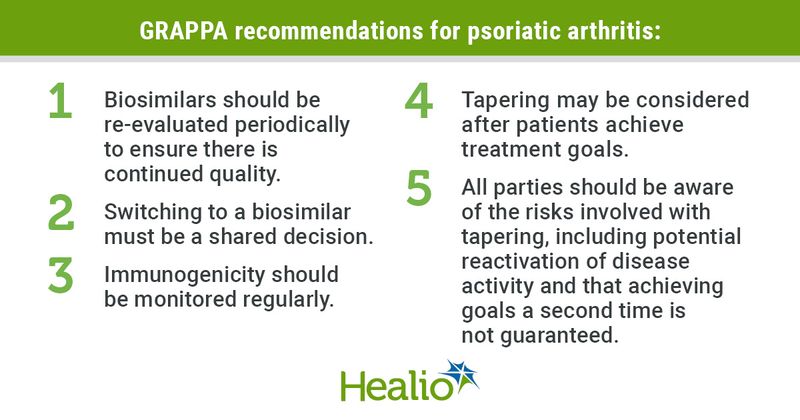Patients may consider tapering once psoriatic arthritis treatment goals are reached
Patients with psoriatic arthritis may consider tapering once treatment goals are reached, according to guidance from the Group for Research and Assessment of Psoriasis and Psoriatic Arthritis published in Nature Reviews Rheumatology.

“The original GRAPPA recommendations were published in 2009, with a revised version in 2015,” Laura Coates, MBChB, MRCP, PhD, of the University of Oxford, and co-authors wrote. “The process to develop this latest version of the recommendations began once again in 2019 in order to address recent important advances in the treatment of PsA.”

To draft new overarching principles and position statements for the management of psoriasis and PsA, the Group for Research and Assessment of Psoriasis and Psoriatic Arthritis (GRAPPA) formed eight subcommittees, one for each disease domain in the group. Subcommittees began by developing questions on population, intervention, comparators and outcomes. Members then performed a literature review informed by these research questions. This literature review included only items published since 2013 to focus on information published since the last recommendations were published.
Data extraction and risk assessments were combined across the disease domains, and studies published through 2020 were included. A survey including potential recommendations was distributed to GRAPPA members in May 2021, and members were instructed to indicate agreement or disagreement as well as minor comments.
In all, the group approved seven overarching principles, which were revised from the 2015 recommendations. According to the principles, the recommendations include the most up-to-date information possible to enable shared decision-making. In addition, they state that the end goal of therapy for these patients is to reach the lowest possible level of disease activity, improve quality of life and avoid as many complications as possible. Assessment of these patients requires providers to assess all disease domains, and clinical assessment should include patient-reported measures and a comprehensive history.
Other overarching principles include:
- Comorbidities should be considered for their potential impact on patients.
- Therapy decisions should be made on an individual basis between the patient and physician.
- Patients should be examined quickly and offered “regular” evaluation.
The position statements offered by the group fall into groups relating to biosimilars and tapering therapies. The statements on biosimilars include:
- Biosimilars must endure a “robust” review before approval.
- Biosimilars should be re-evaluated periodically to ensure there is continued quality.
- In cases where there were no PsA studies for biosimilars, extrapolations may be used.
- Switching therapies must be a shared decision.
- Specific batches and agents must be easily trackable.
- “Multiple switches” should endure “rigorous,” ongoing studies.
- Savings stemming from the use of biosimilars should allow more patients to access therapy.
- Immunogenicity should be monitored regularly.
The positions regarding tapering include:
- Tapering may be considered after patients achieve treatment goals.
- Tapering benefits include lower risks of adverse events and economic benefits.
- The decision to initiate tapering should be a shared decision.
- The decision to taper should be made for every patient individually.
- All parties should be aware of the risks involved with tapering, including potential reactivation of disease activity and that achieving goals a second time is not guaranteed.
The authors added that it is not possible to predict which patients can successfully taper, and that the impact of tapering on other outcomes is not easily understood.
“Given the heterogeneity of disease presentation of PsA, individualization of therapy is crucial,” the authors wrote. “With this update, GRAPPA has maintained a domain-based approach as well as a focus on comorbidities to guide treatment selection for individuals.”
